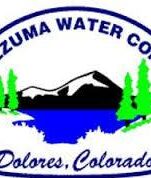About Chloramines
Montezuma Water Company implemented the use of chloramines to meet current and future regulations required by the Environmental Protection Agency (EPA) and the Colorado Department of Public Health and Environment (CDPH&E). Montezuma Water Company started using chloramines in the Dove Creek portion of the system in 2004. Since that time TTHMs have been reduced by as much as 47%. The injection of chloramines in the rest of the system began in December of 2010 and should be completed in March of 2011. MWC has approximately 1,000 miles of mainlines providing service to parts of three (3) counties. The use of chloramines is the best solution to supplying the members with the safe and great tasting water that we are accustomed to receiving.
Research shows that chloramines play a major role in disinfecting pathogens, controlling tastes and odors, oxidizing inorganics and organics, and suppressing microbiological growth in distribution systems. For utilities with extensive distribution systems and long detention times, chloramines aid in maintaining disinfectant residuals. Chloramines also have been found to produce fewer total trihalomethanes (TTHMs) than free chlorine.
Because they are more stable and less reactive than free chlorine, chloramines as secondary disinfectants help maintain a detectable residual throughout the distribution system. Although chloramines are weaker disinfectants and require greater contact times than chlorine, utilities that experience bacterial re-growth in their distribution systems and switch to chloramines find that chloramines apparently penetrate deeper into the biofilm layer to inactivate microorganisms and inhibit their growth.
Are chloramines new?
No. Many cities in the U. S. and Canada have used chloramines for decades. Denver, Colorado, for instance, has used chloramines since 1917. Other cities using this treatment process include Washington, D.C., San Francisco, Boston, Dallas, Indianapolis, Miami and St. Louis. Ute Water of Grand Junction, one of the largest rural water systems in the state, started using chloramines in January 2007.
Chloraminated water is safe for bathing, drinking, cooking and all uses we have for water every day. However, there are two groups of people who need to take special care with chloraminated water: kidney dialysis patients and fish owners.
What are trihalomethanes (TTHMs)?
TTHMs are chemical compounds that are formed when chlorine mixes with naturally occurring organics in water. The U. S. Environmental Protection Agency (EPA) conducted tests which determined that chloroform (one of the TTHMs) is carcinogenic when consumed by laboratory animals in large quantities over a prolonged period of time, and is a suspected carcinogen for people. EPA set a standard of 80 parts per billion as the safe maximum level of TTHMs in drinking water.
What about people who are sensitive to chemicals?
The amount of chloramines will be extremely small – no more than 2 parts per million parts of water. If you are concerned that even this low concentration might cause problems for you, check with your physician. The predominant type of chloramines will be monochloramine NH2Cl) and will be in the ratio of 4 parts chlorine to one part ammonia.
1 Part Per Million Chloramine equivalent to 1cc of ammonia + 4 cc of chlorine + 1320 gallons of water.
Will chloramines change the pH of the water?
No. The pH of the water will remain the same as before.
What will water taste like with chloramines?
If you notice any change at all, you may find the water has less of a chlorine odor or taste.
Will a carbon filter remove chloramines?
Yes. However, it must contain high quality granular activated carbon and you must permit sufficient contact time.
